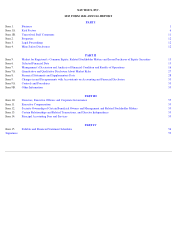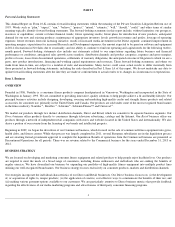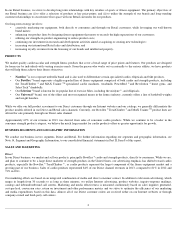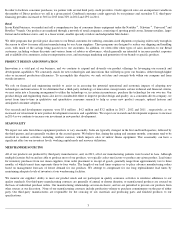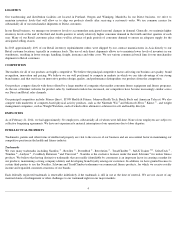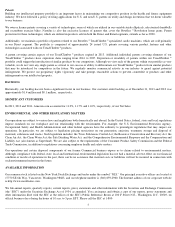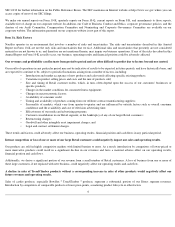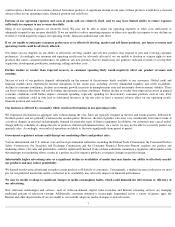Nautilus 2013 Annual Report Download - page 13
Download and view the complete annual report
Please find page 13 of the 2013 Nautilus annual report below. You can navigate through the pages in the report by either clicking on the pages listed below, or by using the keyword search tool below to find specific information within the annual report.
A delay in getting non-U.S.-
sourced products through port operations and customs in a timely manner could result in reduced sales,
canceled sales orders and unanticipated inventory accumulation.
Most of our imported products are subject to duties or tariffs that affect the cost and quantity of various types of goods imported into the U.S. or
our other markets. The countries in which our products are produced or sold may adjust or impose new quotas, duties, tariffs or other
restrictions. Further, our business depends on our ability to source and distribute products in a timely manner. As a result, we rely on the free
flow of goods through open and operational ports worldwide. Labor disputes at various ports create significant risks for our business, particularly
if these disputes result in work slowdowns, lockouts, strikes or other disruptions during our peak importing seasons. Any of these factors could
result in reduced sales, canceled sales orders and unanticipated inventory accumulation and have a material adverse effect on our operating
results, financial position and cash flows.
Unpredictable events and circumstances relating to our international operations, including our use of non-
U.S. manufacturers, could
have a material adverse effect on our business.
Substantially all of our products are manufactured outside of the U.S. and a portion of our revenue is derived from sales outside the U.S.,
primarily in Canada. Accordingly, our future results could be materially adversely affected by a variety of factors pertaining to international
trade, including: changes in a specific country's or region's political or economic conditions; trade restrictions; import and export licensing
requirements; changes in regulatory requirements; additional efforts to comply with a variety of foreign laws and regulations; and longer
payment cycles in certain countries, thus requiring us to finance customer purchases over a longer period than those made in the U.S. In addition,
we rely on the performance of our employees located in foreign countries. Our ability to control the actions of these employees may be limited
by the laws and regulations in effect in each country. Changes in any of the above factors could have a material adverse effect on our operating
results, financial position and cash flows.
Currency exchange rate fluctuations could result in higher costs, reduced margins or decreased international sales.
Substantially all of our products are manufactured outside of the U.S. and, therefore, currency exchange rate fluctuations could result in higher
costs for our products, or could disrupt the business of independent manufacturers that produce our products, by making their purchases of raw
materials more expensive and more difficult to finance. Our future financial results could be significantly affected by the value of the U.S. dollar
in relation to the foreign currencies in which we, our customers or our suppliers conduct business. Past fluctuations in the Chinese Renminbi
exchange rate have caused our costs for certain products to increase, reducing our margins and cash flows. Similar fluctuations and cost
increases may occur in the future. If we are unable to increase our selling prices to offset such cost increases, or if such increases have a negative
impact on sales of our products, our revenues and margins would be reduced and our operating results and cash flows would be negatively
impacted. In addition, a portion of our revenue is derived from sales outside the U.S., primarily in Canada. Currency rate fluctuations could
make our products more expensive for foreign consumers and reduce our sales, which would negatively affect our operating results and cash
flows.
We may face competition from providers of comparable products in categories where our patent protection is limited or reduced due to
patent expiration. Increased competition in those product categories could negatively affect our future revenues and operating results.
A patent covering aspects of our TreadClimber
®
products expired during 2013. Although we own a number of other patents covering aspects of
our TreadClimber
®
products, the introduction of comparable products designed to compete with our TreadClimber
®
line of specialized cardio
machines may increase in the future as a result of these patent expirations. Sales of cardio products, especially Bowflex
®
TreadClimber
®
products, represent a substantial portion of our Direct segment revenues. Introduction by competitors of comparable products, a maturing
product lifecycle or other factors could result in a decline in our revenues derived from these products. A significant decline in our sales of these
products would have a material adverse effect on our operating results, financial position and cash flows.
Failure or inability to protect our intellectual property could significantly harm our competitive position.
Protecting our intellectual property is an essential factor in maintaining our competitive position in the health and fitness industry. Failure to
maximize or to successfully assert our intellectual property rights could impact our competitiveness. We rely on trademark, trade secret, patent
and copyright laws to protect our intellectual property rights. Many factors bear upon the exclusive ownership and right to exploit intellectual
properties, including, without limitation, prior rights of third parties and nonuse and/or nonenforcement by us and/or related entities. While we
make efforts to develop and protect our intellectual property, the validity, enforceability and commercial value of our intellectual property rights
may be reduced or eliminated. We cannot be sure that our intellectual property rights will be maximized or that they can be successfully asserted.
There is a risk that we will not be able to obtain and perfect our own or, where appropriate, license intellectual property rights necessary to
compete successfully within the
9



